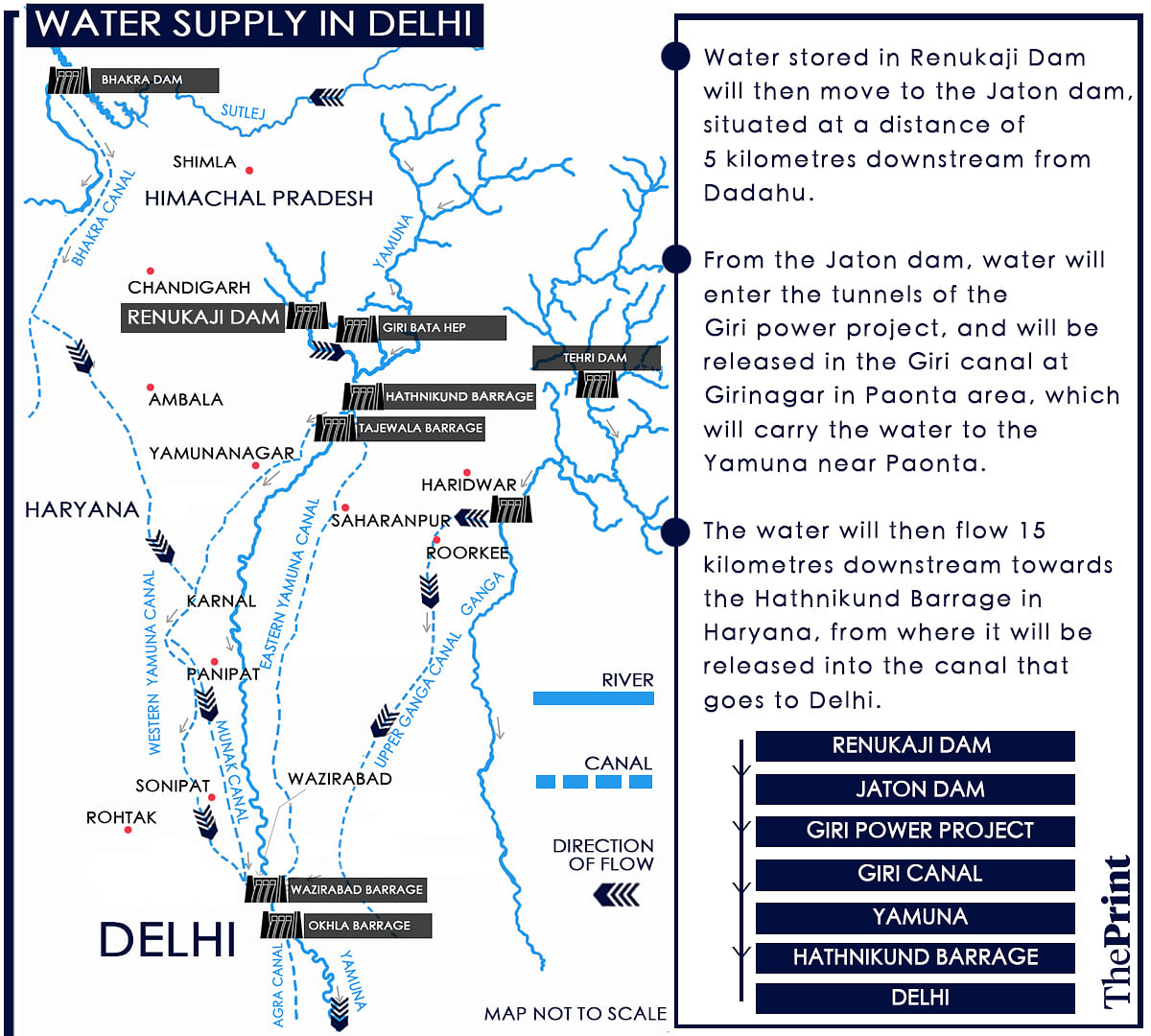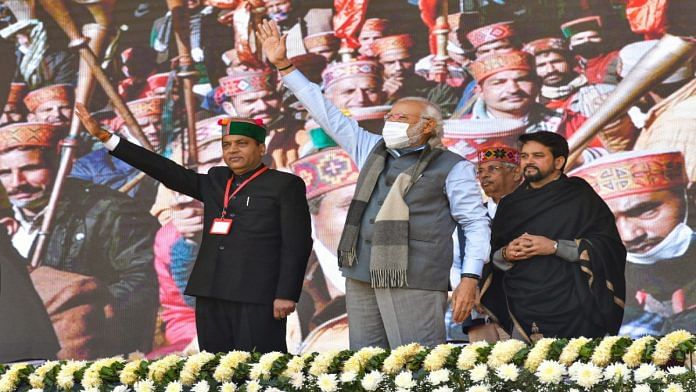Shimla: Fifty-five years after it was first conceived by government experts, the Renukaji Multi-Purpose Project — located in Himachal Pradesh’s Sirmaur district — is all set to become a reality.
On 27 December 2021, Prime Minister Narendra Modi, in a virtual event, laid the foundation for the Renukaji dam, which is set to cost Rs 6,946 crore and has been touted as the solution to Delhi and the National Capital Region’s decades-old drinking water problem.
Significantly, the project is slated to be completed just before the Delhi assembly elections in 2025.
According to the central government, the Renukaji project will be “immensely beneficial” to the national capital, which will be able to receive around 500 million cubic metres of water per year. It will also boost power production in Himachal Pradesh, generating revenue of Rs 120 crore.
The Himachal government has projected a boom in the local economy due to river rafting, water sports etc., besides thousands of job opportunities in the area, once the project is operational.
Four other beneficiary states — Haryana, Uttar Pradesh, Uttarakhand and Rajasthan — will also get water from the project for drinking and irrigation purposes.
The 55-year delay in getting a green signal for the national status project can be attributed to many reasons — red tapism, apathy of politicians belonging to both the Congress and the BJP, as well as opposition from locals and environmental groups. For 27 years, the Himachal government kept commissioning various surveys and submitting reports to the central and Delhi governments for technical and forest clearances. In this time, the cost of the project also skyrocketed by several hundred crore rupees.
The cumbersome exercise finally paved the way for financial approval on 15 December, at a meeting of the Cabinet Committee on Economic Affairs (CCEA), chaired by PM Modi.
Also Read: Delhi’s water shortage problem finally has a solution — 3 dams across Yamuna
Tracing the project and its benefits
Built on the Giri river, a tributary of the Yamuna, the Renukaji dam site is near Dadahu in Himachal Pradesh, 250 kilometres from Delhi. It is proposed to be executed by the Himachal Pradesh Power Corporation Limited (HPPCL).
The the 148-metre-high rock-filled structure will be able to store 498 million cubic metres of water in its reservoir. The stored water of the Renukaji dam will be channelled to Delhi-NCR, UP and Haryana from the Hathnikund Barrage, to Delhi-NCR again from the Wazirabad Barrage, and to UP, Haryana and Rajasthan from the Okhla Barrage.
The project is a part of the Pradhan Mantri Krishi Sinchayee Yojana (PMKSY), a scheme for irrigation and efficient use of water. With a live storage of 0.404 million acre feet (MAF), the reservoir is designed to supply 23 cubic meters of water (23,000 litres) per second to Delhi.
Experts say the flow of the Giri will increase by nearly 110 per cent, enough to meet the drinking water needs of the national capital and other basin states in the lean period.
It will also generate 40 MW power (installed capacity) of incidental power production in Himachal, generating a revenue of Rs 120 crore, according to the government.

Procedural hurdles
Official records show that although surveys related to the Renukaji dam began in 1976, procedural hurdles were created at every step. The estimated cost of the project was Rs 4,596 crore in 2015. It has escalated to Rs 6,946 crore now.
After years of delay, on 11 January 2019, the Memorandum of Understanding (MoU) for construction of the project was signed by chief ministers of the six beneficiary states — Jai Ram Thakur (Himachal), Manohar Lal Khattar (Haryana), T.S. Rawat (Uttarakhand), Arvind Kejriwal (Delhi), Ashok Gehlot (Rajasthan) and Yogi Adityanath (Uttar Pradesh) — in the presence of then-Union water resources minister Nitin Gadkari.
Gadkari held several rounds of meetings with chief ministers of the beneficiary states to sort out intra-state disputes on sharing of water and other benefits from the Renukaji project.
The late former chief minister of Delhi Sheila Dikshit had also pursued the project for 15 years during her three tenures. She succeeded in getting it declared as a ‘project of national importance’ during Manmohan Singh’s second term as prime minister in 2010. Current Delhi CM Arvind Kejriwal also continued the efforts.
But it was the Union government that accelerated the process of various clearances after 2015. This culminated in the 15 December meeting of the CCEA that cleared the project and agreed to bear 90 per cent of the cost.
Former Himachal Pradesh governor Bandaru Dattatreya had reviewed the progress of the project and written to Union Minister for Water Resources Gajendra Singh Shekhawat to expedite the process of granting investment clearance by the Cabinet, which yielded results.
According to the clauses of the MoU, 90 per cent cost of the irrigation and drinking water component of the project (Rs 3,892 crore) will be provided by the central government, whereas 10 per cent (Rs 432.54 crore) will be borne by the six beneficiary states, in proportion to the allocation of water.
As a result, Haryana will pay 47.82 per cent of the beneficiary states’ share, Uttar Pradesh and Uttarakhand will pay 33.65 per cent each, Rajasthan 9.34 per cent and Delhi 6.04 per cent.
Himachal has already spent on the project since it began. Delhi and Haryana have also contributed their share to become eligible for the dam’s benefits.
Environmental clearances
One of the reasons the Renukaji project was delayed was opposition from the local population and environmental groups who feared displacement of 800 families residing in 35 villages, apart from serious environmental concerns pertaining to loss of biodiversity in the area.
However, the state government has projected a boom in the local economy due to water sports and creation of “thousands” of job opportunities in the area. It has claimed that 1,508 hectares will be in the submergence zone due to this project, and that compensation has been given to affected families and enhanced amount will be given in time.
At present, the statutory clearances of environment and forest have been obtained. A total of Rs 577.62 crore will be deposited in Himachal’s Compensatory Afforestation Fund Management and Planning authority (CAMPA) account for rehabilitation.
Political significance
The foundation ceremony of the Renukaji project was followed by PM Modi attending a massive rally in Mandi the same day. The fact that the project to quench Delhi’s thirst is aimed to be completed in February 2025, around the same time as the assembly elections, is viewed as the BJP’s way to take on Kejriwal’s two-term incumbent Aam Aadmi Party.
Locally too, the PM’s rally is being seen as a morale booster for BJP workers and leaders in Himachal, with assembly elections scheduled towards the end of 2022. In the last round of bypolls in November 2021, the BJP had staggeringly lost on three assembly seats, and the Mandi Lok Sabha seat too.
(The writer is a political analyst and ex-senior editor of Hindustan Times, Rajasthan)
This article has been updated to reflect that Bandaru Dattatreya is former governor of Himachal Pradesh. The error is regretted.
Also Read: 9.1 crore Indians don’t have basic water supply. But India isn’t paying attention



